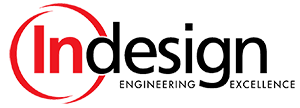Indesign featured in R&D Magazine
Indesign, LLC, a nationally recognized engineering design firm specializing in electronic product development was featured in the October 2009 issue of R&D magazine.
The content below was taken from the article:
“Understanding Contract Labs”, By Lindsay Hock, Managing Editor
Inside Electronic/Software Development Labs
Like materials testing labs, Indesign LLC, Indianapolis, IN, an electronics development and engineering services lab, is no stranger to following strict standards and requirements. Indesign LLC is an “ISO 9001 certified development house. We have detailed design and development processes for each of our design disciplines,” says Jerry Gotway, president and CEO of Indesign LLC. The services Indesign offers range from full product development design, product design engineering, creating prototypes, test engineering services, and more.
Indesign can help any company with any of their electronic and software development needs. Gotway says, “Where we come into the development process varies. We prefer to be involved in the very front end of product development. Many clients that we serve have already done all the product concept work and have developed a detailed set of requirements or specs.” With the requirements and specs already laid out, Indesign will do the detailed design work following the specs.
From medical devices, to mechanical products, to electrical products, all testing gets back to the set of requirements the company provides. With the typical development process starting at requirements, then heading into architecture, then schematics, the PCB layout stage, procuring parts and building PCB assemblies, testing the design, and then releasing their prototype to the factory, Indesign has the proper equipment to aid in the development. Indesign has equipment that ranges from digital scopes and spectrum analyzers to environmental chambers for temperature and humidity testing. Gotway says, “As we go through the design process, and we start building prototypes, we perform validation testing to verify that the prototypes have met all the requirements the company has stipulated.” The testing equipment allows Indesign to meet those requirements and verify the methods used are within the standards.
Because Indesign’s focus is helping companies design and develop electrical, mechanical, and software products, a challenge they sometimes face, according to Gotway, is “that Indesign is designing or developing something that does not exist previously.” And, since they are creating a new product, there is always uncertainty of how each component will come together. “One of the challenges is being able to deal with the unexpected when creating something new,” says Gotway. Despite any unexpected event, the lab must stick to a tight schedule and stay on it. According to Gotway, “we must be able to quickly address any issue that comes up.”
Gotway has observed many trends within the electronics development. “Over the past several years a larger percentage of our new product designs have evolved from wired to wireless designs,” he says. Because users no longer want to be “tethered with a wire” when using their electronic products, Indesign has used many standard wireless protocols in their product designs. Within software, Gotway has seen a lot of Linux being used for embedded software designs. Also within electronics, he has seen new developments in battery technology and a trend to go low power. “Most portable products are often limited based on the available battery life. This has created new developments in battery technology, as well as low power circuit components and circuit design,” says Gotway.
To read the entire article click on this link: Understanding Contract Labs
